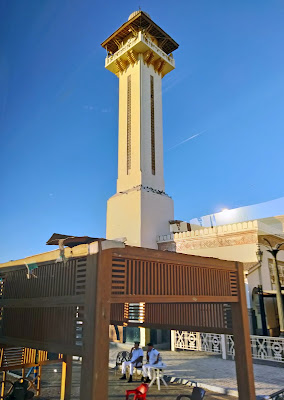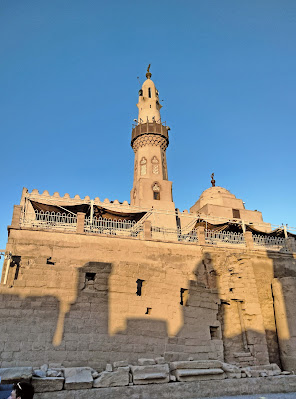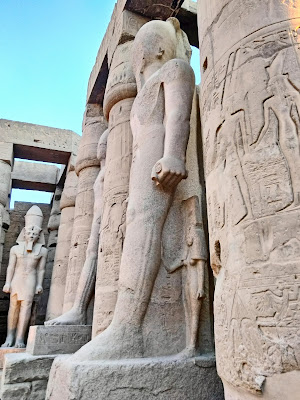Another included excursion took us by motor coach to the Luxor Temple in the evening.
 |
| Ahmed Negm Mosque with its "control tower" minaret |
 |
| First pylon of Luxor Temple (c 1400 BCE), which is devoted to the Royal Ka rather than to a god; three of these statues of Ramesses II are original out of six (one is behind the obelisk) |
 |
| The seated colossal figures of Ramesses II that flank the gateway are said to be original |
 |
| Both of the seated figures wear the double crown of Upper and Lower Egypt |
 |
| Chapel of Serapis, was built by Hadrian, and is the only remaining Roman structure |
 |
| The Luxor Obelisk (c 1250 BCE) is one of a pair of obelisks; however, one was given to France in 1830 by Muhammed Ali (now in Paris at Place de la Concorde); this remaining obelisk is leaning |
 |
| Four baboons at the base of the obelisk represent Babi, a deification of the hamadryas baboon, who act as guards |
 |
| In the Great Court of Ramesses II, Abu Haggag Mosque (640 CE) was built on top of part of the temple that was converted into a Coptic Church in 395 CE |
 |
| The Triple Barque Shrine for the ceremonial boats for the triad of Amun, Mut, and Khonsu |
 |
| More colossal statues of Ramesses II between columns with lotus-bud capitals |
 |
| A smaller figure of Queen Nefertari pushes the royal leg of Ramesses II to remind him who is in charge |
 |
| Two more seated figures of Ramesses II flank the entrance to the Colonnade of Amenhotep III with columns topped by open papyrus capitals |
 |
| Geographically, there were two sets of "enemies" for Egypt, first Asians from the east ... |
 |
| ... then Africans from the south |
 |
| Sun Court of Amenhotep III with what here are called papyrus-bundle columns |
 |
| In a corner that was plastered are paintings of Roman officials |
 |
| Reliefs depicted the Opet Festival, when a procession carried the statues of Amun, Mut and Khonsu from the Karnak Temple to the Luxor Temple; here we see back-bending acrobats |
 |
| It's getting too dark, but we get to view the temple with lights |
 |
| Two Nile River gods unite Upper (represented by a lotus) and Lower Egypt (represented by papyrus) by tying a knot |
 |
| The Avenue of Sphinxes connects Karnak Temple with Luxor Temple, and the 2.7 m/1.7 mile length is lined with sphinxes with human heads |
 |
| The lighted Luxor Temple |
 |
| Back at the lighted Viking Aton |
 |
| Each night, regional specialties were offered for dinner; this is a starter of figs stuffed with labneh/ a yogurt based cheese with honey and pistachios |
 |
| Braised perch fillet on tomato rice, with okra |
 |
| Dessert was qatayef/pancake stuffed with walnut, raisins, and cream filling, then fried |



No comments:
Post a Comment